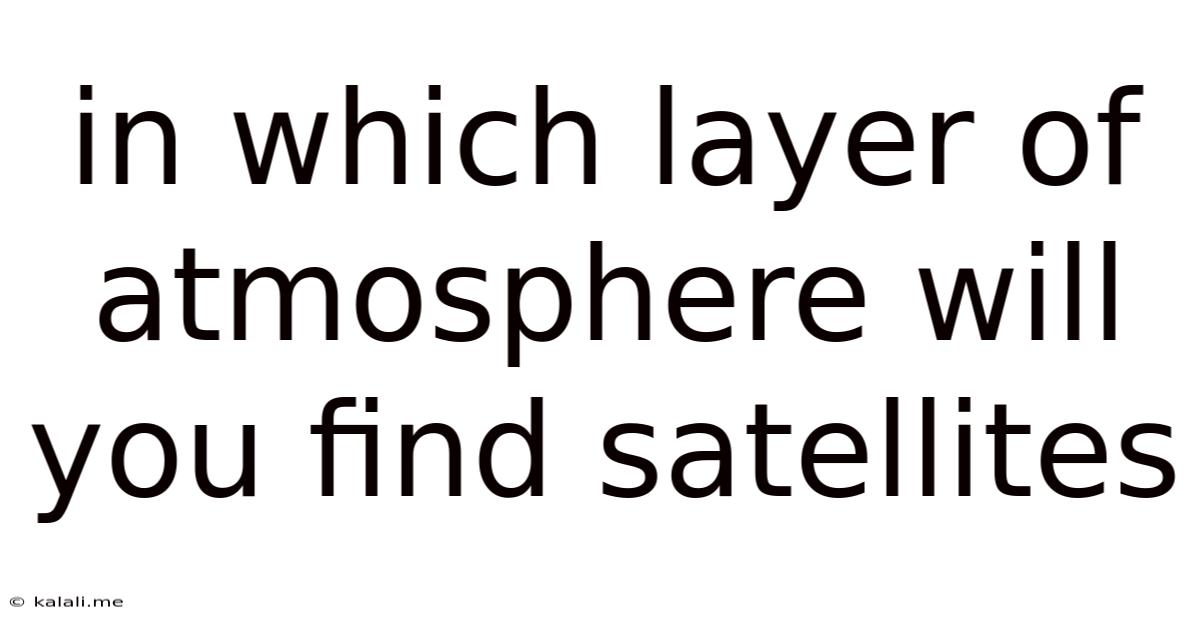In Which Layer Of Atmosphere Will You Find Satellites
Kalali
Jun 11, 2025 · 3 min read

Table of Contents
In Which Layer of the Atmosphere Will You Find Satellites? Beyond the Exosphere
Many people wonder where exactly satellites orbit Earth. The simple answer isn't a single layer of the atmosphere, but rather a region beyond the Earth's atmosphere. While the atmosphere extends far out into space, the vast majority of satellites reside in the exosphere and beyond, in what's often referred to as space. Let's dive deeper into why.
This article will explore the different layers of the Earth's atmosphere, explain why satellites aren't found within them, and detail the specific region where these crucial pieces of technology operate. We'll also touch upon the various types of satellite orbits.
Understanding Earth's Atmospheric Layers
Earth's atmosphere is divided into several layers based on temperature gradients:
- Troposphere: This is the layer closest to the Earth's surface, containing most of the atmosphere's mass and weather patterns. Airplanes typically fly in the lower troposphere.
- Stratosphere: Known for its ozone layer, which absorbs most of the Sun's harmful ultraviolet radiation.
- Mesosphere: The coldest layer of the atmosphere, where meteors burn up upon entry.
- Thermosphere: Characterized by extremely high temperatures due to absorption of high-energy solar radiation. The aurora borealis and aurora australis occur in this layer.
- Exosphere: The outermost layer, where the atmosphere gradually fades into space. The boundary between the exosphere and space is not clearly defined.
Why Satellites Aren't Found in Lower Atmospheric Layers
Satellites cannot operate within the troposphere, stratosphere, mesosphere, or even the lower thermosphere due to significant atmospheric drag. This drag, caused by friction with air molecules, would slow down and eventually cause a satellite to fall back to Earth. The density of the atmosphere in these layers is simply too high to allow for sustained orbital flight.
Where Satellites Actually Orbit: Beyond the Exosphere
Most operational satellites are found orbiting well beyond the exosphere, in the region considered to be space. While there's no hard and fast boundary, the Kármán line, at an altitude of 100 kilometers (62 miles), is commonly used as a demarcation. Above this line, the atmospheric density is so low that aerodynamic lift becomes irrelevant, and orbital flight becomes possible.
This region beyond the exosphere is where the gravitational pull of the Earth is still strong enough to maintain satellites in orbit, yet the atmospheric drag is negligible. It's important to note that even in this region, there are still extremely faint traces of atmospheric particles, but their density is so low that it has a minimal effect on satellites.
Types of Satellite Orbits
Satellites orbit Earth at various altitudes and inclinations, depending on their purpose. Common orbit types include:
- Low Earth Orbit (LEO): These satellites orbit at relatively low altitudes, typically between 200 and 2,000 kilometers. They are often used for Earth observation, communication, and navigation.
- Medium Earth Orbit (MEO): These satellites orbit at altitudes between 2,000 and 35,786 kilometers. They are commonly used for navigation systems, such as GPS.
- Geostationary Orbit (GEO): These satellites orbit at an altitude of approximately 35,786 kilometers above the equator, matching the Earth's rotation. This allows them to appear stationary from the ground, making them ideal for communication and weather monitoring.
- High Earth Orbit (HEO): These satellites orbit at altitudes beyond MEO. They are often used for scientific research and observation.
In conclusion, while the atmosphere extends far out, the practical location for satellites is significantly beyond the exosphere, in the region commonly referred to as space. The negligible atmospheric drag at these altitudes allows satellites to maintain their orbits for extended periods, fulfilling their various roles in communication, navigation, scientific research, and more.
Latest Posts
Latest Posts
-
How Old Are You If You Were Born In 2002
Jul 01, 2025
-
How Many Sides Does A Star Have
Jul 01, 2025
-
How Many Ears Of Corn In A Can
Jul 01, 2025
-
What Grade Is A 15 Out Of 20
Jul 01, 2025
-
What Determines The Direction A Pwc Will Travel
Jul 01, 2025
Related Post
Thank you for visiting our website which covers about In Which Layer Of Atmosphere Will You Find Satellites . We hope the information provided has been useful to you. Feel free to contact us if you have any questions or need further assistance. See you next time and don't miss to bookmark.